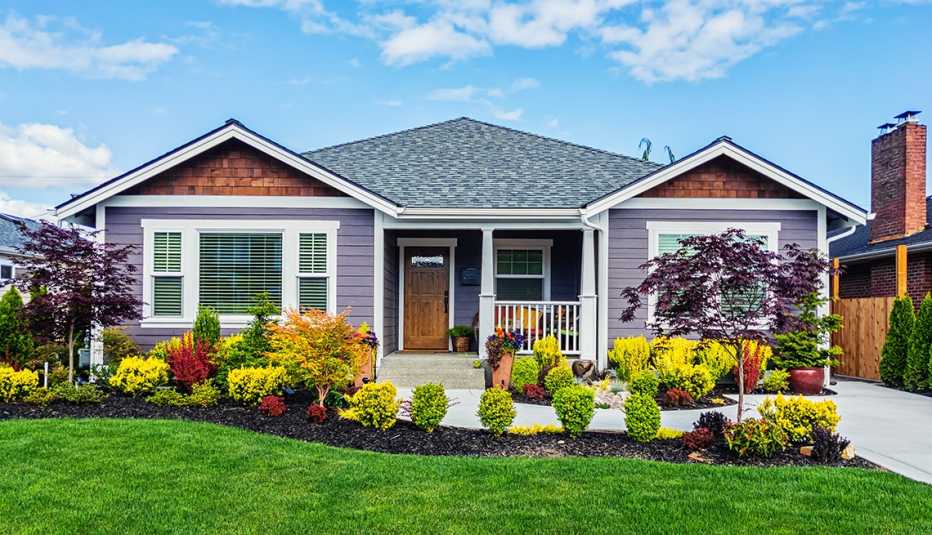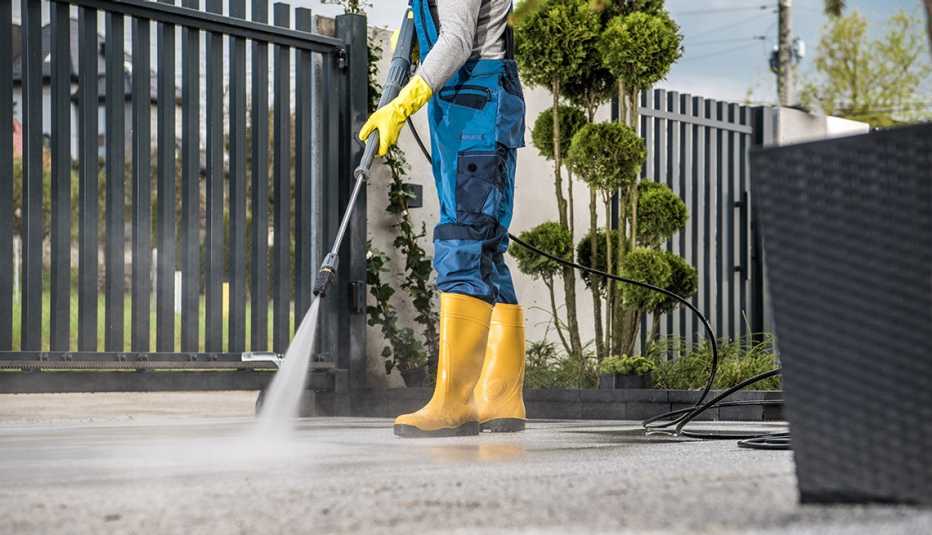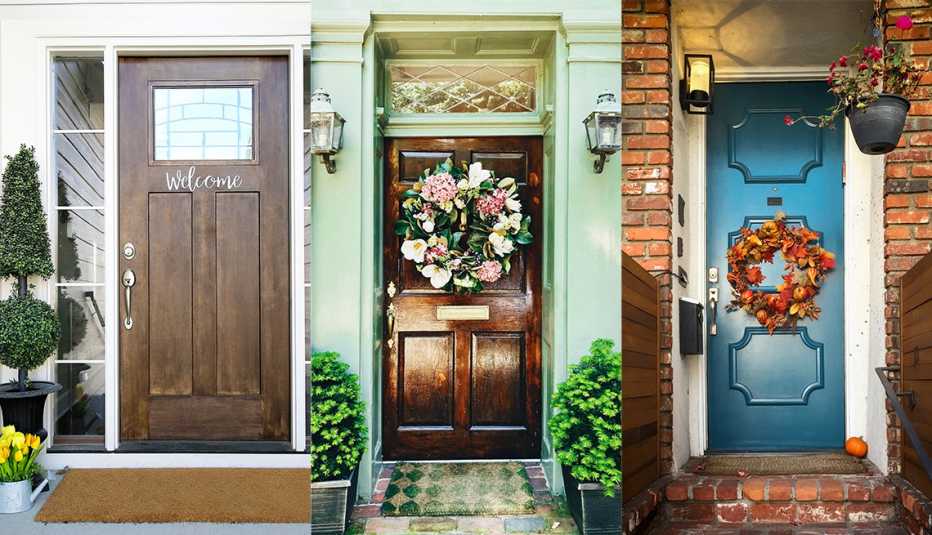AARP Hearing Center


That thing that makes you stop and stare at a home in the middle of your neighborhood while on a stroll? It’s curb appeal. And when a house has it, there’s no fighting the allure. It might be a front door with color that pops, a porch with smile-worthy seating, or landscaping that’s so flawless you’re tempted to take notes for your own lawn overhaul.
Perfecting curb appeal means your home radiates a good first impression — whether for potential buyers, guests or simply neighbors passing by.
Some curb appeal upgrades may cost very little. Others could require a considerable financial outlay. But either way, expect to receive an eventual return on your investment: Houses with strong curb appeal tend to sell for an average of 7 percent more than comparable homes that lack a curbside wow factor, according to a 2020 study in The Journal of Real Estate Finance and Economics.
Want your humble abode to be a neighborhood knockout? Here’s how.


START SMALL
1. Do a visual once-over
Step back and eye your home as if you are an interested home buyer or first-time passerby. Notice anything slightly askew that you had been overlooking? Perhaps the storm door is hanging just a little ajar, or maybe the shutters aren’t even. Spend an afternoon making small repairs to keep your home’s front in tip-top visual shape.
2. Tidy up
“Keeping things neat and tidy is a very easy way to make sure your home makes a great first impression,” says Bailey Carson, a home care expert at the home services and directory website Angi, formerly known as Angie’s List.
Is last fall’s project ladder still leaning on the side of the house? Are those pavers out of place and in need of being relaid? The easiest way to add curb appeal is to simply put items away. If they’re not getting put away because there’s no room in the shed or garage, it’s time to declutter and organize.
3. Get rid of the grime
Cobwebs, dirt, dead leaves — or, worse, mold and mildew — can build up on your home’s exterior and around windows, doors, gutters and eaves. So, set aside time to clean your home’s exterior at least semiannually. Pick a sunny day, look from different angles and try to see with fresh eyes what everyone else sees. There are a lot of expensive chemicals and cleaners that tout special properties, but soap and water in a bucket with a sponge go a long way.
You can also consider using a pressure washer to clean brick, sidewalks and the exterior of your home. “I’m a big fan of the pressure washer, which you can buy or rent at most home-improvement stores,” Carson says. “If you spend a Saturday putting in just a little bit of sweat equity with one, it can make a big difference on your driveway and walkways.”
4. Clean windows and door glass
Help your home shine by scrubbing away any dust and fingerprints on your front window panes, both inside and out. “Having newly cleaned, glistening windows makes a world of difference for curb appeal,” says Jennifer Davis, a broker with Maison Real Estate in Charleston, South Carolina. “When your windows are clean, light streams through and brightens all the rooms in the house.”
5. Keep outdoor decor to a minimum
Don’t overdo the yard decor — even if that means limiting your garden gnome collection to just two or three favorites, or limiting the quirkiness to the backyard. Too much can be a distraction and make the area look cluttered.


FOCUS ON THE FRONT
6. Paint or stain your front door
Make your front door pop with a coat of fresh paint. One recent Zillow study suggests homes with black doors deliver the most curb appeal, selling for around $6,500 more than similar homes — or opt for teal, red or yellow for a cheery blast of color. If natural wood doors are more your style, liven yours up with a new coat of golden oak or rich mahogany stain.
“I’m seeing more and more people going for natural stains as opposed to painted doors,” says Charles DeBaptiste, owner of a Door Renew franchise in Wilkes-Barre, Pennsylvania. If you have a nonwood door but like that look, there are multiple products for getting a wood-textured look through paint. Search “wood grain paint kit” online to find.
7. Or replace your door entirely
If you’ve noticed drafts coming from your existing door — or if the door casing around it has warping, cracking or other signs of weather damage — it may be time to replace it. The good news is that you’ll get to take your pick from a range of styles and materials, including tried-and-true wood and energy-efficient insulated steel or fiberglass.
Take a nod from your home’s architecture to select a new front door that feels right for your entryway, whether traditional, Craftsman, Old World or modern. And consider both style and security when selecting whether — or how much — glass should be incorporated in your front door design.
8. Add a wreath and a welcome mat
Accentuate your front door makeover by adding a cheery wreath and a new welcome mat. It’s a one-two punch that can instantly take your house from cold to cordial. For bonus points, rotate your wreath and mat with the changing seasons so your entryway feels fresh year-round. And when it comes to choosing a wreath, don’t always default to a traditional shape.
“If your front door has two long windows, or sidelights, on the sides, rather than using a traditional round wreath, you can create two elongated wreaths that fit perfectly in those spaces,” suggests Mattie Sheppard, a strategic interior design adviser at Real Estate Bees and president and CEO of Perfectly Pictured Decluttering & Staging Experts in Jacksonville, Florida.
9. Use planters for a pop of color
Add two matching pots or planters, placed at either side of your door or porch walk-up, filled with in-season annuals such as geraniums, petunias, impatiens and chrysanthemums. This burst of color will help frame and showcase your front door. If you’re looking for inspiration, aim for “thrillers, fillers and spillers” when researching. Start your planters with a tall focal plant — perhaps an ornamental grass — and then fill out around it, using smaller annuals and vines, suggests Leslie Feathers, a designer with Belmont Nursery in Fresno, California.
10. Add seating
If you have a front porch that’s large enough for gathering, embrace it. Add a cozy swing or bench, a colorful outdoor rug and a row of comfy rocking chairs or Adirondack chairs placed perfectly for conversation. In warmer climates, an outdoor fan helps keep bugs at bay and creates a cooling breeze. This all gives a house “a warm inviting feeling that says, ‘Come on in. You’re welcome here,’ ” Sheppard says.
11. Liven up your light fixtures
If your home has basic, contractor-grade porch lights, consider adding some pizzazz with new light fixtures. For a modern look, opt for a pair of black or muted brass lanterns or a set of painted steel fixtures that are equally at home in farmhouse or modern industrial designs.
“Even just updating the lanterns on either side of your front door can add a really nice touch — and it’s a relatively easy DIY project,” Carson says.
12. Revamp your railings
If your current front stairway or raised porch railings are rusted or rotted — depending on if they’re metal or wood — or if they wobble and are no longer securely grounded, it’s time to repair or replace them. The visual makeover will add noticeable curb appeal, plus the new, sturdier handrails and railings can help prevent accidents and falls.

































































More AARP Smart Guides
Find the Best Vacation Rental
28 tips on planning — and enjoying — your time away
Efficiently Clean Your Home
Room by room, now’s the time to tackle your to-do list
Manage Seasonal Allergies
Achoo! How to understand and treat your symptoms